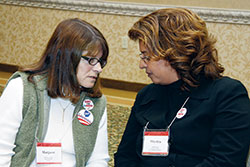
|
|
Fired up by UUP President Phillip Smith’s no-nonsense assessment of the devastating mid-year cuts to the University, new and veteran leaders vowed to do whatever it takes to protect SUNY’s core mission.
“I read all the information I receive from the union, but the state budgetcrisis and what it means for SUNY didn’t really hit home until now,” said Karin Killough of Plattsburgh, one of nearly 120 UUP members taking part in the Fall Leadership Workshops and Chapter Presidents/Vice Presidents Meeting Oct. 17-18 in Syracuse.
“The time for action is now.”
Killough’s comments came after Smith made it abundantly clear that every UUP member must become involved in the union’s advocacy efforts to keep SUNY as strong as ever. He called on the activists to reach out to local business leaders, community organizations, parents and students, and urge them to send faxes to the governor telling him that “SUNY is the solution” to New York’s grim economic picture.
“What we’re facing today is not anything like what we’ve faced in the past,” Smith said. “Before, there was money and UUP asked that SUNY be given its fair share. Now, there isn’t any money. This is not business as usual.”
Mohammed Nurhussein, a doctor of internal medicine at Brooklyn HSC, admits he’s a long-time union member who only recently became an advocate for UUP and SUNY.
“I feel I need to be active in UUP, especially because of the state deficit problems and with SUNY being asked to make concessions that we strongly oppose,” Nurhussein said. “UUP needs to think proactively to protect its members.”
Smith said he and the other officers have been working behind the scenes to convince the governor that SUNY is the solution to the state’s fiscal woes. He also noted that the union’s message has been trumpeted in close to 50 radio, TV and newspaper reports around the state.
“I can talk to government leaders and educate them on why it’s important to invest in SUNY, but I can’t do it alone,” Smith said. “I need your help in making the case—one legislator at a time—that it is shortsighted to damage SUNY, the one state agency capable of creating wealth.”
SUNY has a proven multiplier effect on communities. Every dollar spent on the state university generates an average of between $6 and $8 to the local economy. To cite some examples: UAlbany contributes $3 billion a year to the regional economy; Upstate Medical University generates more than $2 billion in economic activity for the Syracuse region; and the University at Buffalo is that area’s largest employer, with an annual economic impact of $1.5 billion.
“We have very good arguments for why SUNY should not face further cuts,” Smith said. “We just have to get more people to join us in making those arguments.”
UUP Outreach Committee Co-chair Glenn McNitt of New Paltz gave new and veteran leaders the tools they need to help spread the word. McNitt distributed a UUP Local Advocacy Handbook that outlines the union’s key points, as well as a list of resources to assist members in building coalitions with community-based businesses and individuals with a stake in SUNY.
“No matter how well any of us do our jobs, SUNY may cut programs and services, and reduce funding for academic and professional faculty,” McNitt said. “You need to go back and tell your members it’s time to act like their jobs depend on it. They might.”

